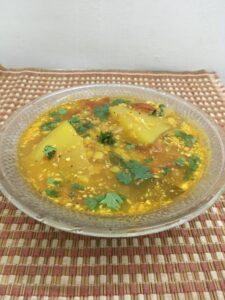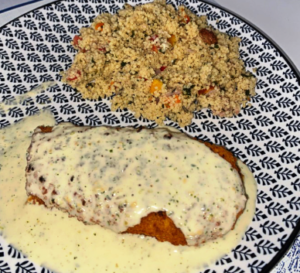Mango Sambar is a popular and delicious South Indian dish made with lentils, vegetables, tamarind, and of course, ripe mangoes. It is a perfect blend of tangy, spicy, and sweet flavors that make it a delightful and nutritious meal. In this blog post, we will explore the history and facts behind Mango Sambar, along with its nutritional benefits and how to make it at home.
Mango Sambar has a long history and is believed to have originated in the Southern state of Tamil Nadu, India. It was traditionally prepared during the mango season, which is from April to June. The dish was originally made with only lentils, vegetables, and tamarind, and the addition of mangoes is a more recent innovation.
Facts:
- Mango Sambar is a staple dish in South Indian cuisine and is commonly served with steamed rice or idli (a type of savory cake).
- It is typically made with toor dal (split pigeon peas), but other lentils such as moong dal (split green gram) or chana dal (split Bengal gram) can also be used.
- The dish gets its tangy flavor from the tamarind, which is a sour fruit commonly used in Indian cooking.
- The sweetness of the ripe mangoes balances out the tanginess of the tamarind, making it a perfect blend of flavors.
- Mango Sambar can be made with a variety of vegetables such as drumsticks, pumpkin, brinjal (eggplant), okra, and more.
- The dish is often spiced with mustard seeds, cumin seeds, fenugreek seeds, red chili powder, and turmeric powder.
- It is a rich source of protein, fiber, vitamins, and minerals, making it a healthy and nutritious meal option.
Nutritional Benefits: Mango Sambar is a nutritious dish that is packed with essential vitamins and minerals. The lentils used in the dish provide a good source of protein and fiber, which are important for maintaining a healthy diet. Additionally, the vegetables used in the dish add a variety of vitamins such as vitamin A, C, and K. The tamarind used in the dish is also a good source of antioxidants, which help in reducing inflammation and promoting overall health.
Recipe

Ingredients
- 1 cup toor dal (split pigeon peas)
- 2 cups water
- 1 small ripe mango, peeled and chopped
- 1 small onion, chopped
- 2-3 garlic cloves, minced
- 1 small piece of ginger, grated
- 1-2 green chilies, slit
- 1 medium-sized tomato, chopped
- 1 tsp mustard seeds
- 1 tsp cumin seeds
- 2-3 dried red chilies
- A pinch of asafoetida
- 1/4 tsp turmeric powder
- 1 tbsp sambar powder
- Salt, to taste
- 1 tbsp oil
- Fresh coriander leaves, chopped
Method
- Wash the toor dal in water and soak it for 10-15 minutes. Then, pressure cook it with 2 cups of water for 5-6 whistles or until it becomes soft and mushy.
- In a pan, heat the oil and add mustard seeds. Once they start spluttering, add cumin seeds, dried red chilies, and asafoetida. Saute for a few seconds.
- Add onions, garlic, ginger, and green chilies. Saute until the onions become translucent.
- Add chopped tomatoes and cook until they become soft and mushy.
- Add the chopped mangoes, turmeric powder, sambar powder, and salt. Mix well.
- Add the cooked toor dal to the mango and onion mixture. Add some water if the sambar is too thick. Cook on low flame for 5-6 minutes.
- Finally, add some fresh coriander leaves and serve hot with steamed rice.
2 responses to “Mango Sambar: A Delicious and Nutritious South Indian Delight”
-
I don’t think the title of your article matches the content lol. Just kidding, mainly because I had some doubts after reading the article.
-
Your article helped me a lot, is there any more related content? Thanks!




Leave a Reply